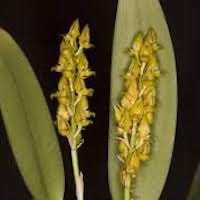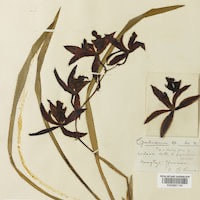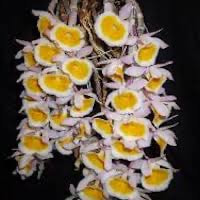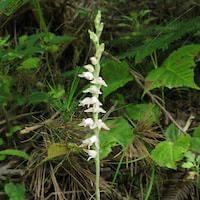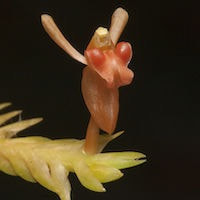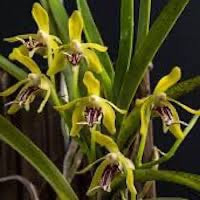WFL12 - Women's Floral 12 - HeavenLily
|
Native Singaporean Orchid notes: Cattleya (dolosa ‘Alba’ x schilleriana)
Cattleya (dolosa ‘Alba’ x schilleriana) is a hybrid orchid used in the Floral 12 (Women) perfume for a team-building workshop. This orchid features a blend of two parent plants: dolosa with large white flowers and a sweet fragrance, and schilleriana with rich mahogany petals and a deep pink lip. The combination of these characteristics creates a beautiful and fragrant flower. The mix of colors and scents from this hybrid makes it a great choice for crafting elegant perfumes.
|
Therapeutic Orchid notes:
|
Bulbophyllum neilgherrense
Bulbophyllum neilgherrense is an orchid from southern India, especially the Malabar and Nilgiri Hills regions. It blooms with yellow flowers in February and is known for its pleasant fragrance. Besides adding a unique scent to perfumes, its pseudobulbs are used as a tonic for boosting energy and refreshment. This orchid's aroma and revitalizing properties make it a valuable ingredient in fragrance blends. |
|
Cymbidium wilsonii (Rolfe ex De Cock) Rolfe
Cymbidium wilsonii, also known as Duanyechutou Lan or Diannanhutou Lan in Chinese, is an orchid that adds to fragrance blends with its purplish-red lips that appear from February to April. It has been used in traditional medicine from Yunnan to treat respiratory issues and body aches. Cymbidium orchids, cultivated for over 2,000 years, contain aromatic compounds and new antiviral lectins that may help prevent diseases like HIV and CMV. These properties enhance both the orchid’s scent and its therapeutic potential. |
|
Dendrobium gratiosissimum Rchb. f.
Dendrobium gratiosissimum, also known as King Dam in Thailand and Hoa thao, huang thao, and Long tu in Vietnam, is a fragrant orchid species. In Indochina, it is used for its potential therapeutic properties under the name "shihu," though specific uses are not detailed. This orchid’s unique scent enhances perfume blends, and its traditional medicinal use suggests it may have health benefits. Overall, Dendrobium gratiosissimum adds both fragrance and potential therapeutic qualities. |
|
Goodyera schlectendaliana Rchb. f.
Goodyera schlectendaliana, known by various names like Dabanye Lan (Large speckled orchid) in Chinese, and Miyama uzura (Quail of the deep mountain) in Japanese, is a dwarf orchid from China, Japan, and Southeast Asia. It contains a compound called Goodyerin, which has sedative and anti-convulsant effects. In Traditional Chinese Medicine, it is used to treat lung issues, coughs, and pain, and a poultice of its leaves helps relieve pain. This orchid’s unique fragrance and medicinal properties make it a valuable addition to perfumes and herbal remedies. |
|
Liparis dunnii Rolfe
Liparis dunnii, known in Chinese as Dachunyangersuan (big lip sheep ear garlic) and Fujianyangersuan (Fujian Province goat ear garlic), is a rare orchid native to central Fujian Province. Discovered in 1903, it grows on rocks at Tze Chuk Hang. In Chinese medicine, it is called Shuangyejinqiang, though details about its fragrance are unclear. This orchid’s unique name and rarity add a special touch to fragrance blends and highlight the natural beauty of Fujian Province. |
|
Vanda cristata Wall ex Lindl. Syn. Trudelia cristata (Wall ex Lindl.) Senghas
Vanda cristata, known as Chachunwandai Lan in Chinese, Bhyagute phul in Nepali, and Jyo koke thitkhwa in Myanmar, is an epiphytic orchid found in Nepal, Bhutan, northern India, Tibet, and southwest Yunnan. This orchid contains a compound called laburnine acetate, which has antimicrobial properties. In traditional medicine, Vanda cristata is used in various ways: its paste treats cuts and wounds, while its root paste helps with boils and dislocated bones. The leaf powder is used as an expectorant, and the plant is a nutrient and tonic in herbal practices. |
Other scent note
Scentopia Library Reference ingredient
Iris - Check details at Scentopia's scent library
Download the guided mediation that works best with this Orchid fragrance oil
| women_floral_essential_oil_orchi_00012.mp3 | |
| File Size: | 60764 kb |
| File Type: | mp3 |

